The Mistery
about SMPTE ST 2110
about SMPTE ST 2110
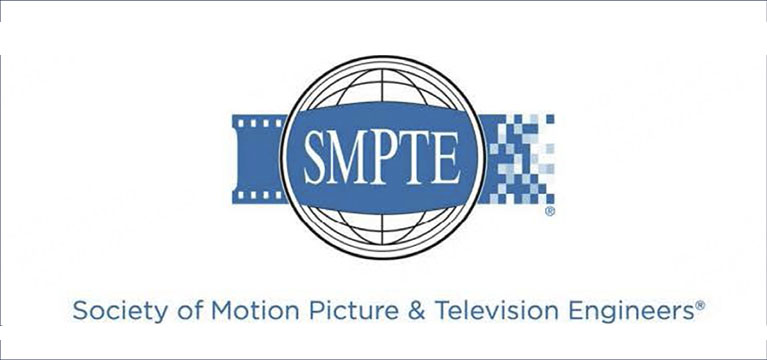
Traditional audio and video solutions for broadcast television are currently constrained by bandwidth and the stability and convenience of connection. In the pursuit of superior visual experience and networked applications of the broadcast video industry, commonly used interfaces such as HDMI, DP and SDI, dedicated cables, limited transmission distance and restricted bandwidth adapted to traditional systems have turned out to be bottlenecks.
The ST 2110 interface released by SMPTE (Society of Motion Picture and Television Engineers) features the advantages of universal IP facilities, ultra-long distance transmission, video source backup, matrix switching and low latency, thus becoming the fundamental technology supporting multi-device interconnection and networked applications for future systems. At present, ST 2110 has demonstrated its powerful functions in broadcast television, sports events and remote productions.
Based on ST 2110 technology, PIXELHUE has released a complete video reception and processing solution. Q8, updated to V1.3.0, has become the world's first seamless presentation switcher equipped with ST 2110 input subcard. Paired with ST 2110, the powerful Q8 enables multiple matrix switching, backup, and management of multi-channel video streams over 10 kilometers, fully and easily coping with any complex on-site environment.
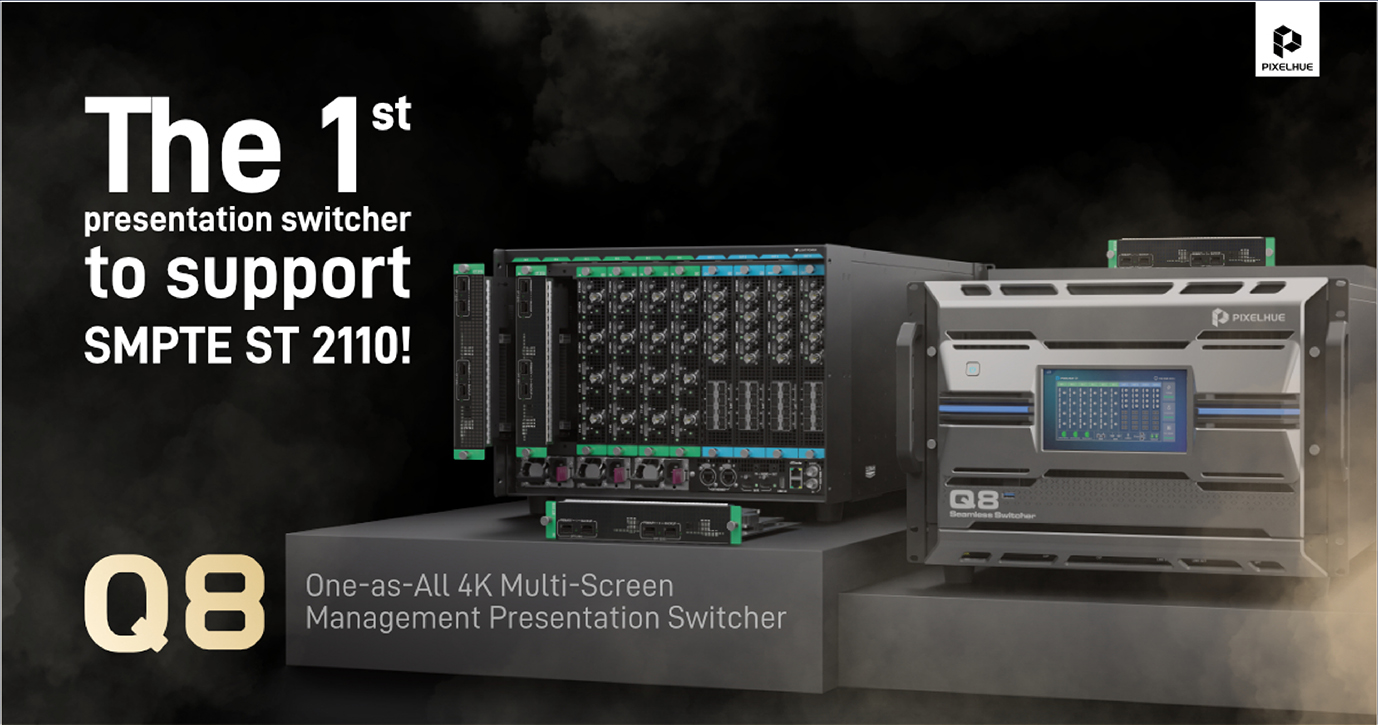
1.PIXELHUE ST 2110 solution
1.1 Introduction to ST 2110 subcard
-
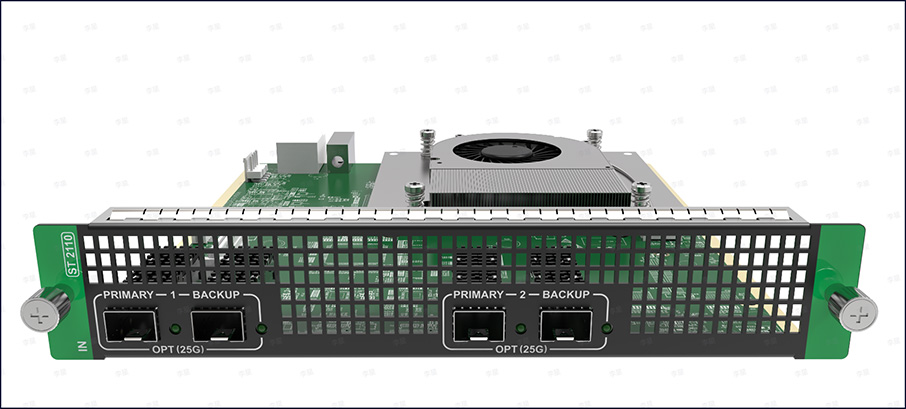 Figure 1.1 ST 2110 2 primary and 2 backup input subcard
Figure 1.1 ST 2110 2 primary and 2 backup input subcard -
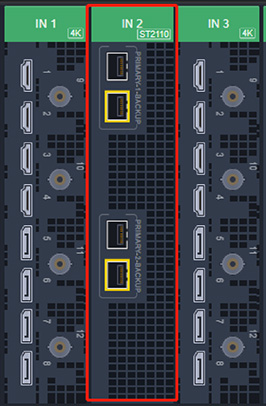 Figure 1.2 PixelFlow interface of ST 2110 2 primary and 2 backup input subcard
Figure 1.2 PixelFlow interface of ST 2110 2 primary and 2 backup input subcard
The release of V1.3.1 makes Q8 the world's first switcher that supports ST2110 video interface, and the 2 primary and 2 backup input subcard and PixelFlow interface are shown in Figure 1.1 and Figure 1.2.
A single subcard implements 2 primary and 2 backup functions based on the SMPTE 2022-7 standard, and each set of interfaces supports receiving a maximum of 1*4K video stream, compatible with input sources in different formats, BT.601, BT.709 and BT2020 color gamut, as well as RGB , YUV444 and YUV422 color spaces.
A single Q8 can use up to 6*ST 2110 subcards, and the video stream reception can be controlled by open source NMOS software or PixelFlow. In combination with Q8's built-in powerful functions, it is possible to realize various editing and processing of up to 12*ST 2110 video sources. In future versions, the Q8 will be further equipped with 100G one primary and one backup input subcard to achieve up to 24*ST 2110 video streams reception and editing.
1.2 Key functions and features
1. Excellent visual experience: A single subcard supports 2 channels of true 4K lossless input (4096*2160@60Hz, 10bit, 4:4:4 video source), and supports high resolution, high frame rate, high color depth, as well as lossless video source. The Q8 supports up to 12*4K ST 2110 video streams.
2. Multiple backups: A single video source has one primary and one backup interfaces, supporting seamless switching of video sources in the ST2022-7 standard. Together with input source hot backup between the Q8 internal interfaces and backup between devices, triple backup ensures a normal display output in complex on-site environments, thus responding to emergencies with greater ease.
3. Ultra-low latency: Precision Time Protocol (PTP) can reach nanosecond-level precision synchronization, ensuring low-latency display and screen synchronization.
4. Strong compatibility: Supports NMOS software and PixelFlow to jointly manage ST 2110 subcards; Supports NMOS software configuration, SDP file import and advanced parameter setting to pull streams, easily coping with different on-site environments.
5. High flexibility: Traditional interface transmission is replaced by scalable IP network technology, where matrix switching can be realized through software.
1.3 Typical application scenarios
Equipments such as Matrox, Qxl, VFC IP subcards of Disguise media server and Panasonic AW-UE160 integrated camera have ST 2110 output interfaces, while some widely used equipments such as cameras, media servers and PCs only have traditional SDI, HDMI and DP interfaces, which require the ST 2110 conversion box to convert traditional interface video streams into IP-based ST 2110 video sources.
When all ST 2110 nodes are connected to the 25G switcher, the PC device with NMOS software is connected to the 25G switcher through a network cable to switch sending nodes into receiving nodes, so that the PixelFlow or U5 console on the PC can realize different input sources edit on the Q8. Typical application scenarios are shown in Figure 1.3.
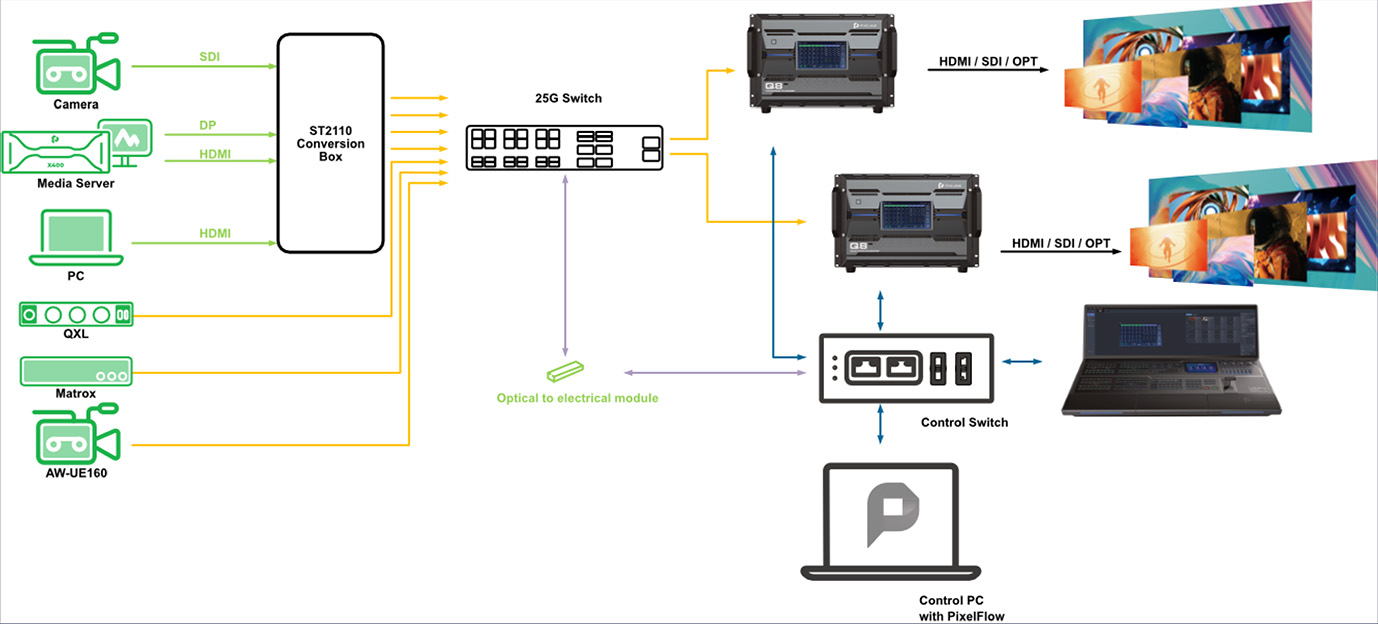
1.4 Commercial value
-
01.
Stable transmission over long distances
The ST 2110 standard takes advantage of established IP network infrastructures, standard Ethernet, IP protocols and open interfaces, allowing connections over single-mode optical fibers for transmission distance of up to 10km or more. -
02.
Strong scalability
ST 2110 standard hardwares are connected in a star topology structure, so that matrix switching of inputs and outputs can be easily achieved by simply focusing on the number of nodes in the environment and by implementing source sequence adjustment and mapping through software configuration. -
03.
Low cost
Post-maintenance of the ST 2110 environment is performed by focusing only on the status of individual nodes, and no additional auxiliary equipment is required for long-distance transmission, significantly minimizing labor and equipment costs.
2.The ST 2110 standard
and transmission method
2.1 The ST 2110 standard

Figure 1.4 The evolution of ST 2110 standard and its components
• The ST 2110 standard consists of four main parts: ST 2110-10 for timing and synchronization, ST 2110-20 for video, ST 2110-30 for audio, and ST 2110-40 for auxiliary data.
• ST 2110-10 defines the format of IP data packets, such as PTP protocol, RTP timestamp and SDP protocol.
• ST 2110-20 standardizes uncompressed video transmission via the Internet.
• ST 2110-30 standardizes uncompressed audio transmission via IP networks based on AES67.
• ST 2110-40 standardizes how to encapsulate and transport ancillary data by using Real-time Transport Protocl (RTP).
• ST 2110-10 defines the format of IP data packets, such as PTP protocol, RTP timestamp and SDP protocol.
• ST 2110-20 standardizes uncompressed video transmission via the Internet.
• ST 2110-30 standardizes uncompressed audio transmission via IP networks based on AES67.
• ST 2110-40 standardizes how to encapsulate and transport ancillary data by using Real-time Transport Protocl (RTP).
2.2 ST 2110 video transmission via IP network
ST 2110 video streaming transmission is a point-to-multipoint service, which is transmitted in multicast form in the IP network. Compared with unicast and broadcast forms, it avoids additional occupation of source devices and network resources, and improves the security of transmission.
The source device only needs to send a single ST 2110 video stream, then the receiving device applies to join the corresponding video stream group through the multicast IP address, and finally the switch forwards the ST 2110 video stream to multiple receiving devices in the current group according to the multicast protocol.
In general, ST 2110, as the core standard for IP-based video workflow, has very optimistic development prospects. As the market develops and technology advances, it will continue to play an important role and drive innovation and development in the field of video production and distribution. PIXELHUE will also continue to increase investment in research and development, develop new technologies, develop new functions, and serve users.